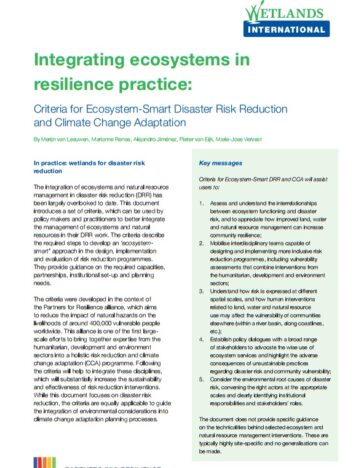
Living with the floods, not against them
-
Coastal resilience
-
Coastal wetland conservation
-
Rivers and lakes
“Yes, we are illiterate sir, but we are engineers as far as our experience with water and rivers is concerned”, says Phushi Mahato, a villager in the Gosi Kandak floodplains in North-Bihar in India.
 As an outcome of water resource management that failed to understand the role of fluvial regimes in the delta, Phushi and his fellow village members have now become vulnerable to floods while in the past they used to live with the natural flows, with their farming and fisheries fuelled by dynamic and nutrient rich floods.
As an outcome of water resource management that failed to understand the role of fluvial regimes in the delta, Phushi and his fellow village members have now become vulnerable to floods while in the past they used to live with the natural flows, with their farming and fisheries fuelled by dynamic and nutrient rich floods.
Nurturing nature, rather than fighting against natural processes by using rigid infrastructure, is that an effective way to reduce disaster risk for communities?
Wetlands International advocates this approach together with its partners of the PEDRR network and discussed it with academics, engineers and practitioners at the International Risk Reduction Congress (IDRC) in Davos from 24-28 August.Indeed, floods must be given somewhere to go. In our project sites in India we found that embankments and hydraulic structures often impede the flow connectivity severely. Often the floods break through the weakest defenses, causing loss to lives and livelihoods and severe waterlogging in the farm fields behind the dykes. In the Mahanadi delta, 43% of the cultivable area is affected by poor drainage, leading to lower crop productivity and damage to crops. Communities also suffer from fewer fisheries and diseases attributed to stagnant waters. No wonder that they prefer to live with the natural flow and floods.
Wetlands International and Cordaid collaborate to reduce the impact of hazards on the livelihoods of the people in North-Bihar as well as in the Mahanadi Delta in Orissa, based on understanding of ecosystem, natural hazards and livelihood linkages. Interventions to reduce disaster risk include the restoration of the hydrological connectivity in the river basins to reduce water logging and siltation, influencing the regime of upstream hydraulic structures, aligning cropping patterns with high and low river flows, and enhancing community disaster preparedness These large scale landscape interventions are combined with more conventional risk reduction approaches related to preparedness and early warning.
“Integrated Risk Management” was the buzz-word at the global gathering in Davos. There was a high interest of participants in how to integrate ecosystem-smart disaster risk management in resilience practice. In the PEDRR side event on ‘Bridging Disaster Risk Reduction and Climate Change Adaptation through Ecosystem Management’, a lively discussion took place.
Engineers asked ‘how NGOs such as Wetlands International see the collaboration with engineers’. We believe that community views and ecosystem considerations, such as the hydrological connectivity of the entire river basin, should always be assessed and included in the design of structures like dams and embankments. Often, combined ‘grey’ and ‘green’ solutions, are the best way to deal with hazards.
Along the North coast of Java for example we protect eroding coastlines by combining grids of permeable brushwood dams that trap sediment with mangrove restoration. Sea walls don’t work in this environment, as they often collapse in the soft mud and may aggravate erosion. And for mangroves to establish, the sediment balance needs to be restored, hence the engineering measures. We implement this work as part of the Building with Nature Alliance, a collaboration between dredging and consultancy firms, knowledge institutes and NGOs, dedicated to developing sustainable solutions for coastal development.
A good question from a research institute focused on ‘how to weigh the economic benefits upstream with community benefits downstream’. Applying ecosystem based approaches does not mean that we should or can entirely go back to the original nature based system. Upstream interests may be similarly important and hard engineering solutions can also help to reduce disaster. The solution is to bring all stakeholders together and work on fair and sustainable water allocation and to consider the values of the natural resources that may be gained and lost under different regimes.
A key question that came up is ‘how we ensure sustainability of the projects’. There are various measures necessary to ensure this. First of all, the villagers themselves provide the input into the village disaster risk reduction plans. Each village has its own plan, but we also connect those villages that have the same risk context, to ensure interventions with collective benefits and to avoid conflicts. Secondly, community self-management, the strengthening of institutions, the leveraging of development funds, the integration of plans in municipality plans and addressing root causes of risk are all very important factors to insure the sustainability of the interventions.
The IDRC congress was a very valuable exchange between stakeholders with different angels and expertise on resilience practice, who should indeed all sit around the same table and do joint disaster risk reduction assessment and planning to come to true integrated disaster risk reduction. Phushi and his fellow members would like to be there too!
More information:
I recommend people to read further information on how to integrate ecosystems in resilience practice:
For further learning to subscribe for the Massive Open Online Course Disasters and Ecosystems: Resilience in a Changing Climate.
The PEDRR network is Partnership for Environment and Disaster Risk Reduction (PEDRR) is a global alliance of UN agencies, NGOs and specialist institutes.
A project from the Partners for Resilience.
Watch our videos for more views from Phusi’s fellow village members:
Short version:
Long version:



